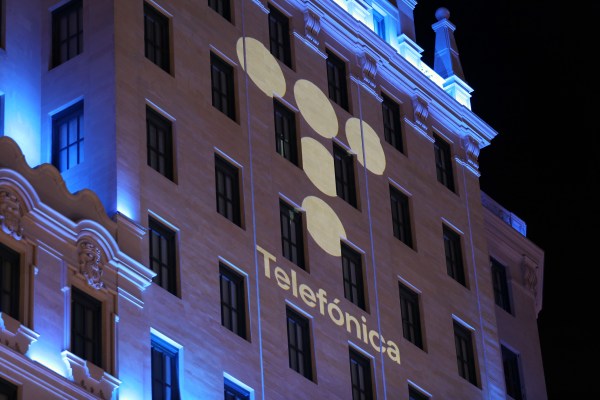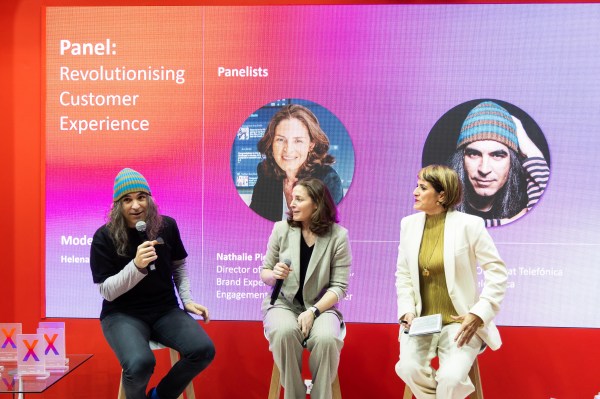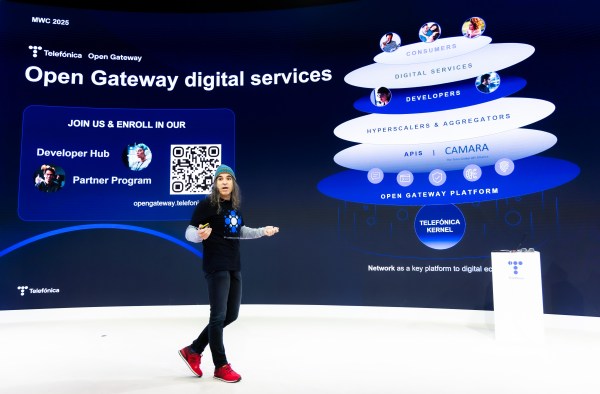Open Gateway is a global initiative led by the GSMA (Global System for Mobile Communications Association) that aims to transform communications networks into platforms. This allows telco capabilities to be opened in an interoperable, intuitive and programmable way.
Simply put, telcos globally are agreeing to open up network capabilities to developers to address quality of service, identity or fraud issues. For example, when banks detect strange transactions, they can use Open Gateway to ensure that the transaction is taking place in the expected location or that the SIM card has not been duplicated to commit a crime.

These network capabilities are exposed through global, standardised APIs.An API is a piece of code that allows different systems to communicate with each other to requests data or other specific actions. In the example above, the two systems communicating are the bank’s application and the network, and they do so via an Open Gateway API. APIs are nothing new. In fact, Telefónica has been using APIs to power the Mi Movistar app and Movistar Plus+ TV for some time now. The big difference is that the APIs, with Open Gateway, are available to developers worldwide.
In the past, if a company or developer was interested in using the capabilities of the network, a tailor-made project with a legal contract was required. This involved months of work, high cost and, in addition, only impacted the devices of one carrier’s network. If it wanted to integrate with more network devices, it had to repeat the same process and tailor-made project with other telcos. Therefore, in its developments it would need an integration for each telco it wanted to operate with. With Open Gateway, any developer can integrate APIs easily and transparently, avoiding the complexity of the network and carriers. One line of code accesses all telcos. This is completely revolutionary and has a major impact on applications.
Why is the Open Gateway project so important?
Open Gateway has a global impact. There are more than 39 telcos worldwide that have signed up to Open Gateway. These telcos account for more than 60% of the world’s traffic and are cooperating to make a single standard.
In the past, telcos have already agreed on a standard, as in the case of roaming. Previously, when a mobile customer in Europe went to Latin America or vice versa, he had to have a separate terminal for each continent. Thanks to roaming, this problem was solved, allowing the same terminal to travel around the world and benefiting the end user. The Open Gateway aims to do something similar, and that is to enable all developers and users around the world to enjoy better experiences and digital services regardless of where they are and what their network is.
Why do all telcos want to reach an understanding?
This project is of great relevance to the customer and end-user when it is multi-telco. The network is not unique, there are many networks deployed around the world belonging to different carriers. For example, by validating a person’s identity with network APIs, if the project were mono-telco, it would only benefit one carrier’s network device. In contrast, with Open Gateway, all devices in the network would benefit, which increases the reach to users.
For this to be possible, standardisation is necessary. CAMARA is the Open Source project, under the framework of the Linux Foundation, which contains the full specification of all APIs. When a telco develops its Open Gateway APIs, the first thing it does is to go to CAMERA and follow the defined interface. This ensures that the standard is met and that it will work for everyone and will be compatible with all telco networks.
What are the benefits of Open Gateway?
Open Gateway benefits all actors in the value chain. Businesses and developers will be able to enrich their apps and generate more value for their business. For example, reducing fraud or getting to know your customer better. As a direct consequence, the end customer will have an improved experience as, in the case of fraud, their money would not be compromised. On the other hand, cloud companies or aggregators that choose to integrate Open Gateway will be able to expand their service offerings on their platforms or marketplace. For telcos, Open Gateway allows them to offer advantageous services to new customers and to enhance the value of their core, theirnetwork.
Which products or services are currently benefiting from Open Gateway?
We have already developed several use cases in which we have validated the benefits they offer to customers.
In banking and insurance, we have conducted several tests focused on anti-fraud and making transactions more secure. One example is the Brazilian bank Daycoval Bank. Their problem was that, as services in the financial sector went digital, security had to be improved to prevent or reduce the risk of fraudulent transactions. To solve this problem, the Vivo Telefónica Brasil group has made use of the Location API Device to verify whether the transaction is carried out where the customer is located and thus confirm that the operation is secure.
In media and entertainment, projects have focused on improving the connection and parameterising the network to provide a better experience for users, gamersand immersive VR experiences. For example, with Blacknut, an online gaming platform, the QoD Mobile API (Quality of Service on Demand) was used to provide gamers a more stable connection during their games, avoiding freezing of images, loss of speed, etc. With Cinfo, an AI, 5G and video company, a live sporting event recorded by AI-driven cameras was streamed in real time in a smooth manner, without video freezing or pixel loss, thanks to the QoD Mobile API.
In travel, virtual training or marketing, we have seen how to offer personalised services thanks to the Know YourCostumer API, which improves the user experience by allowing companies to better profile their customers or offer faster and more secure check-in processes with the Number Verification API. With Zoom, we have also developed a use case to improve the quality of service. Thanks to the QoD WiFi API integrated in webinars, it is possible to achieve stable connections and a better quality of the contents that are reproduced during online trainings.
What are the expectations with Open Gateway?
As we have already seen, Open Gateway is a revolutionary project for the entire telco industry. This 2023 has been completed with the commercial launch of multi-telco Open Gateway in Brazil and Sri Lanka. 2024 will be the year of Open Gateway’s global expansion and fulfilment. A large portfolio of APIs will be available, with many more to come.
What is Telefónica’s role in Open Gateway?
The GSMA, the Global Mobile Ecosystem Association, created the concept of “local champion” to help the management and propagation of Open Gateway in each country around the world that joins the initiative. Telefónica has positioned itself as a local champion in Spain and Brazil, so it is working every day to play an important role in the understanding between telcos and to develop services.

For everyone involved in the initiative’s value chain to get the most out of it, Telefónica Open Gateway has created two programs: the Partner Program and the Developer Hub. The first looks for companies to collaborate and create new innovative joint services, while the second is focused on providing tools to developers to enhance their knowledge. The Developer Hub has a Sandbox, or test environment, to validate use cases and experiment first-hand with the catalog’s APIs. It also has technical documents, webinars and other resources for further training on the initiative.
Historically, Telefónica has always been committed to innovation and the creation of new products and services. So we can say that it is in our DNA. And Open Gateway has the words innovation and revolution in its definition, so it fits perfectly with our goals and our way of understanding the world.










